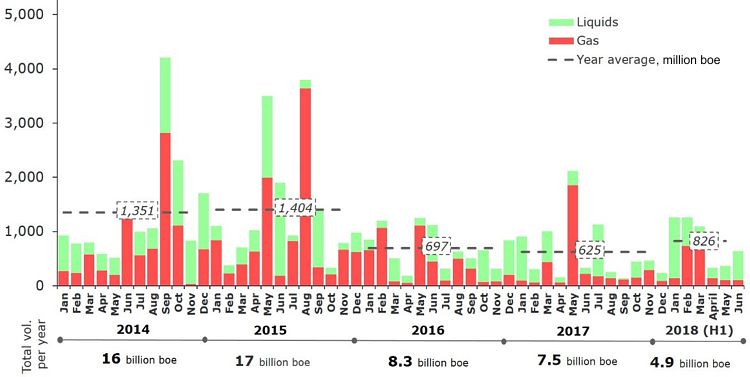Oil & gas discoveries increase in 2018, but reserve replacement ratio remains low
27 July 2018
Global discoveries of conventional oil and natural gas are seeing a recovery with discovered resources already surpassing 4.5 billion boe in the first half of 2018, according to an analysis by Rystad Energy. The average monthly discovered volumes YTD are estimated at 826 million barrels of oil equivalent (boe), up approximately 30% compared to 625 million boe in 2017.

(Source: ECube July 2018, Rystad Energy)
During the first half of 2018, Guyana led the top five countries in terms of total discovered resources added, followed by the United States, Cyprus, Oman and Norway. These five countries hold three-fourths of the total resources discovered this year. “Conventional” resources include onshore and offshore (deepwater), but exclude shale or oil sands.
The discoveries in Guyana, the United States and Cyprus are located in ultra-deepwater and are 100% owned by oil majors, indicating that oil majors have started to re-focus on deepwater exploration. This trend also points to a higher future production costs, compared to conventional onshore resources.
Some of the key 2018 resource discoveries are:
- Guyana—ExxonMobil’s spate of oil discoveries continue in Stabroek block with three major oil discoveries reported in 2018—Ranger, Pacora and Longtail, which together could hold almost 1 billion barrels of oil or more.
- United States—The United States reported oil discoveries at Ballymore and Dover prospects in the Norphlet play in deepwater Gulf of Mexico. The Norphlet play, which is characterized by high-pressure, high-temperature (HPHT) conditions accompanied with complicated and elusive structures revealed to be fortunate for Chevron and a prevailing success for Shell. Chevron discovered a significant oil play at the Ballymore prospect with its first exploration well in the subtle play whereas the Dover discovery located 13 miles from the Appomattox host was Shell’s sixth discovery in the play.
- Cyprus—Cyprus marked its entry in the list owing to Eni’s promising gas discovery at Calypso 1 NFW ultra-deepwater well.
- Oman—Petroleum Development Oman (PDO) announced a giant gas-condensate discovery at Mabrouk North East prospect in the northern part of its concession area located west of Saih Rawl field.
- Norway—In the Norwegian Sea, significant discoveries were reported by OMV and Wintershall in the Aasgard and Aasta Hansteen area respectively, with combined recoverable resources close to 240 million boe. While in North Sea, Aker BP and Equinor made the other two discoveries which together added 75 million boe.
Rystad Energy expects the discovery trend to continue in the second half of 2018, backed by ongoing exploration in emerging offshore provinces and many promising high-impact wells targeting potential resources in the millions.
However, the reserve replacement ratio (the amount of proved reserves added to a company’s reserve base during the year relative to the amount of oil and gas produced) remains low for most oil and gas companies. “An uptick of 30% from the abnormally low levels in 2017 might seem encouraging, but E&P players are currently facing a low reserve replacement ratio, on average of less than 10%. This is worrisome considering the impact on global oil supply in long term,” said Rystad Energy.
In 2017, the world’s oil consumption reached 4622 mtoe (31.63 billion boe) and that of natural gas 3156 mtoe (21.60 billion boe), according to BP Statistical Review of World Energy 2018. Hence, the anticipated 2018 discoveries of some 12 × 826 million boe = 9.91 billion boe would produce an average global oil and gas reserve replacement ratio of just 18.6% (not accounting for unconventional resource discoveries).
Source: Rystad Energy